Step 1:
Step 2:
Step 3:
Step 4:
Step 5:
Step 6:
Step 7:
Step 8:
Step 9:
Step 10:
Step 12:
Step 13:
Step 14:
Step 15:
Step 16:
Step 17:
Step 18:
Step 19:
Step 20:
Step 21:
Service1.svc
using System.Collections.Generic;
using System.Linq;
using WcfService.Basic.BasicDataContext;
namespace WcfService.Basic
{
// NOTE: You can use the "Rename" command on the "Refactor" menu to change the class name "Service1" in code, svc and config file together.
// NOTE: In order to launch WCF Test Client for testing this service, please select Service1.svc or Service1.svc.cs at the Solution Explorer and start debugging.
public class Service1 : IService1
{
private readonly DataContext.BasicDataContext _dataContext = new DataContext.BasicDataContext();
public IList<Person> GetPersonDetails()
{
return _dataContext.Person.ToList();
}
public bool GetSuccessLogins(Login login)
{
var loginSuccess = _dataContext.Login.FirstOrDefault(l => l.UserName == login.UserName && l.Password == login.Password);
return loginSuccess != null;
}
public bool Register(Login login)
{
var registerSuccess = _dataContext.Login.Add(new Login { UserName = login.UserName, Password = login.Password });
_dataContext.SaveChanges();
return registerSuccess != null;
}
public IList<Country> GetCountry()
{
return _dataContext.Country.ToList();
}
public IList<State> GetState(string countryCode)
{
var stateListItems = _dataContext.State.Where(s => s.CountryCode == countryCode).ToList();
var stateList = stateListItems.Select(stateListItem => new State {StateId = stateListItem.StateId, StateCode = stateListItem.StateCode, StateName = stateListItem.StateName, CountryCode = stateListItem.CountryCode, Country = stateListItem.Country}).ToList();
return stateList;
}
public IList<City> GetCity(string stateCode)
{
var cityListItems = _dataContext.City.Where(c => c.StateCode == stateCode).ToList();
var cityList= cityListItems.Select(cityListItem => new City {CityId = cityListItem.CityId, CityCode = cityListItem.CityCode, CityName = cityListItem.CityName, StateCode = cityListItem.StateCode, State = cityListItem.State}).ToList();
return cityList;
}
}
}
Step 22: Set as "Startup project" into WcfService.Basic project before u choosed Packaged Manger Console.
Step 23:
Step 24:
Step 25:
Step 26:
Step 27:
Step 28:
Step 29:
Configuration.cs
using System.Collections.Generic;
using WcfService.Basic.BasicDataContext;
namespace WcfService.Basic.Migrations
{
using System;
using System.Data.Entity;
using System.Data.Entity.Migrations;
using System.Linq;
internal sealed class Configuration : DbMigrationsConfiguration<WcfService.Basic.DataContext.BasicDataContext>
{
public Configuration()
{
AutomaticMigrationsEnabled = false;
}
protected override void Seed(WcfService.Basic.DataContext.BasicDataContext context)
{
// This method will be called after migrating to the latest version.
// You can use the DbSet<T>.AddOrUpdate() helper extension method
// to avoid creating duplicate seed data. E.g.
//
// context.People.AddOrUpdate(
// p => p.FullName,
// new Person { FullName = "Andrew Peters" },
// new Person { FullName = "Brice Lambson" },
// new Person { FullName = "Rowan Miller" }
// );
//
var logins = new List<Login>
{
new Login{UserName = "Arunachala",Password = "Annamalai"},
new Login{UserName = "Test",Password = "Test123"}
};
logins.ForEach(l => context.Login.AddOrUpdate(lo => lo.UserId, l));
context.SaveChanges();
var person = new List<Person>
{
new Person{PersonName = "Venakdesh",PersonCountry = "India",PersonState = "TamilNadu",PersonCity = "Coimbatore"}
};
person.ForEach(p=>context.Person.AddOrUpdate(ps=>ps.PersonId,p));
context.SaveChanges();
var country = new List<Country>
{
new Country{CountryCode = "IN",CountryName = "India"},
new Country{CountryCode = "UK",CountryName = "United Kingdom"}
};
country.ForEach(c => context.Country.AddOrUpdate(ctry => ctry.CountryId, c));
context.SaveChanges();
var state = new List<State>
{
new State{StateCode = "TN",StateName = "TamilNadu",CountryCode = "IN"},
new State{StateCode = "KE",StateName = "Kerala",CountryCode = "IN"},
new State{StateCode = "LV",StateName = "LiverPool",CountryCode = "UK"},
new State{StateCode = "MU",StateName = "Manchester",CountryCode = "UK"}
};
state.ForEach(s => context.State.AddOrUpdate(st => st.StateId, s));
context.SaveChanges();
var city = new List<City>
{
new City{CityCode = "CH",CityName = "Chennai",StateCode = "TN"},
new City{CityCode = "CBE",CityName = "Coimbatore",StateCode = "TN"},
new City{CityCode = "TVM",CityName = "Trivandrum",StateCode = "KE"},
new City{CityCode = "TR",CityName = "Trisur",StateCode = "KE"},
new City{CityCode = "TC1",CityName = "TestCityOne",StateCode = "LV"},
new City{CityCode = "TC2",CityName = "TestCityTwo",StateCode = "LV"},
new City{CityCode = "TC3",CityName = "TestCityThree",StateCode = "MU"},
new City{CityCode = "TC4",CityName = "TestCityFour",StateCode = "MU"}
};
city.ForEach(c => context.City.AddOrUpdate(ct => ct.CityId, c));
context.SaveChanges();
}
}
}
Step 30:
201311140626217_WcfService.Basic.cs
namespace WcfService.Basic.Migrations
{
using System;
using System.Data.Entity.Migrations;
public partial class WcfServiceBasic : DbMigration
{
public override void Up()
{
CreateTable(
"dbo.UserProfile",
c => new
{
UserId = c.Int(nullable: false, identity: true),
UserName = c.String(),
Password = c.String(),
})
.PrimaryKey(t => t.UserId);
CreateTable(
"dbo.Person",
c => new
{
PersonId = c.Int(nullable: false, identity: true),
PersonName = c.String(),
PersonCountry = c.String(),
PersonState = c.String(),
PersonCity = c.String(),
})
.PrimaryKey(t => t.PersonId);
CreateTable(
"dbo.Employee",
c => new
{
EmployeeId = c.Int(nullable: false, identity: true),
EmployeeName = c.String(),
EmployeeDesignation = c.String(),
UserId = c.Int(nullable: false),
})
.PrimaryKey(t => t.EmployeeId)
.ForeignKey("dbo.Person", t => t.UserId, cascadeDelete: true)
.Index(t => t.UserId);
CreateTable(
"dbo.Country",
c => new
{
CountryCode = c.String(nullable: false, maxLength: 3),
CountryId = c.Int(nullable: false, identity: true),
CountryName = c.String(),
})
.PrimaryKey(t => t.CountryCode);
CreateTable(
"dbo.State",
c => new
{
StateCode = c.String(nullable: false, maxLength: 3),
StateId = c.Int(nullable: false, identity: true),
StateName = c.String(),
CountryCode = c.String(maxLength: 3),
})
.PrimaryKey(t => t.StateCode)
.ForeignKey("dbo.Country", t => t.CountryCode)
.Index(t => t.CountryCode);
CreateTable(
"dbo.City",
c => new
{
CityCode = c.String(nullable: false, maxLength: 3),
CityId = c.Int(nullable: false, identity: true),
CityName = c.String(),
StateCode = c.String(maxLength: 3),
})
.PrimaryKey(t => t.CityCode)
.ForeignKey("dbo.State", t => t.StateCode)
.Index(t => t.StateCode);
}
public override void Down()
{
DropIndex("dbo.City", new[] { "StateCode" });
DropIndex("dbo.State", new[] { "CountryCode" });
DropIndex("dbo.Employee", new[] { "UserId" });
DropForeignKey("dbo.City", "StateCode", "dbo.State");
DropForeignKey("dbo.State", "CountryCode", "dbo.Country");
DropForeignKey("dbo.Employee", "UserId", "dbo.Person");
DropTable("dbo.City");
DropTable("dbo.State");
DropTable("dbo.Country");
DropTable("dbo.Employee");
DropTable("dbo.Person");
DropTable("dbo.UserProfile");
}
}
Step 31:
Step 32:
Step 33:
Step 34:
Step 35:
Step 36:
Step 37:
Step 38:
Step 39:
Step 40:
Step 41:
HomePageController.cs
using System;
using System.Collections.Generic;
using System.Linq;
using System.Web;
using System.Web.Mvc;
namespace BasicMvcApplication.Controllers
{
public class HomePageController : Controller
{
//
// GET: /HomePage/
private readonly BasicWcfService.Service1Client _basicWcfService1Client = new BasicWcfService.Service1Client();
public ActionResult Login()
{
_basicWcfService1Client.GetPersonDetails();
return View("~/views/BasicViews/LoginPage.cshtml");
}
[HttpPost]
public ActionResult Login(LoginViewModel loginViewModel)
{
var login = new BasicWcfService.Login
{
UserName = loginViewModel.UserName,
Password = loginViewModel.Password
};
var result = _basicWcfService1Client.GetSuccessLogins(login);
if (result)
{
var countryList = _basicWcfService1Client.GetCountry();
var countryItems = countryList.Select(country => new SelectListItem {Text = country.CountryName, Value = country.CountryCode}).ToList();
var homeViewModel = new HomeViewModel { LoggedUserName = login.UserName,PersonCountry = countryItems,PersonState = new List<SelectListItem>(),PersonCity = new List<SelectListItem>()};
return View("~/views/BasicViews/HomeView.cshtml", homeViewModel);
}
return RedirectToAction("Login");
}
public ActionResult Register()
{
return View("~/views/BasicViews/RegisterView.cshtml");
}
[HttpPost]
public ActionResult Register(LoginViewModel loginViewModel)
{
var login = new BasicWcfService.Login
{
UserName = loginViewModel.UserName,
Password = loginViewModel.Password
};
var registerResult = _basicWcfService1Client.Register(login);
if (registerResult)
return View("~/views/BasicViews/HomeView.cshtml");
return View("~/views/BasicViews/LoginPage.cshtml");
}
}
}
Step 42:
HomeViewModel.cs
using System;
using System.Collections.Generic;
using System.ComponentModel.DataAnnotations;
using System.Linq;
using System.Web;
using System.Web.Mvc;
namespace BasicMvcApplication.Controllers
{
public class HomeViewModel
{
public int PersonId { get; set; }
public string LoggedUserName { get; set; }
public string PersonName { get; set; }
public string PersonCountryCode { get; set; }
[Display(Name = "Person Country")]
public IEnumerable<SelectListItem> PersonCountry { get; set; }
public string PersonStateCode { get; set; }
[Display(Name = "Person State")]
public IEnumerable<SelectListItem> PersonState { get; set; }
public string PersonCityCode { get; set; }
[Display(Name = "Person City")]
public IEnumerable<SelectListItem> PersonCity { get; set; }
}
}
Step 43:
LoginViewModel.cs
using System;
using System.Collections.Generic;
using System.ComponentModel.DataAnnotations;
using System.Linq;
using System.Web;
namespace BasicMvcApplication.Controllers
{
public class LoginViewModel
{
public int UserId { get; set; }
[Display(Name = "User Name")]
public string UserName { get; set; }
[Display(Name = "Password")]
public string Password { get; set; }
}
}
BasicViews=>HomeView.cshtml
@using System.Web.Mvc.Html
@model BasicMvcApplication.Controllers.HomeViewModel
@{
ViewBag.Title = "HomeView";
}
<h2>HomeView</h2>
@using (Html.BeginForm(FormMethod.Post))
{
@Html.Label("Current User Name:")
@Html.DisplayFor(m => m.LoggedUserName)<br />
@Html.LabelFor(m => m.PersonCountry)
@Html.DropDownListFor(m => m.PersonCountryCode, Model.PersonCountry, "--Select--", new { @id = "ddlCountry" })<br />
@Html.LabelFor(m => m.PersonState)
@Html.DropDownListFor(m => m.PersonStateCode, Model.PersonState, "--Select--", new { @id = "ddlState" })<br />
@Html.LabelFor(m => m.PersonCity)
@Html.DropDownListFor(m => m.PersonCityCode, Model.PersonCity, "--Select--", new { @id = "ddlCity" })
}
<script src="~/Scripts/jquery-1.7.1.js"></script>
<script src="~/Scripts/ui.ajax.js"></script>
<script src="~/Scripts/ui.ajaxNavigate.js"></script>
<script src="~/Scripts/ui.js"></script>
<script type="text/javascript">
$(document).ready(function () {
$('#ddlCountry').change(function () {
var countryCode = $("#ddlCountry").val();
$.get("/api/FillState/StateForPersonCountry", { countryCode: countryCode }, function (data) {
var listItems = "";
var jsonData = data;
for (var i = 0; i < jsonData.length; i++) {
listItems += "<option value='" + jsonData[i].Value + "' selected='" + jsonData[i].Selected + "'>" + jsonData[i].Text + "</option>";
}
$('#ddlState').html(listItems);
});
// var uRl = "@Url.Action("StateForPersonCountry", "TestHomePage")'" + "/" + countryCode;
});
$('#ddlState').change(function () {
var stateCode = $("#ddlState").val();
$.get("/api/FillState/CityForPersonState", { stateCode: stateCode }, function (data) {
alert('Test');
var listItems = "";
var jsonData = data;
for (var i = 0; i < jsonData.length; i++) {
listItems += "<option value='" + jsonData[i].Value + "' selected='" + jsonData[i].Selected + "'>" + jsonData[i].Text + "</option>";
}
$('#ddlCity').html(listItems);
});
});
});
</script>
Step 45:
LoginPage.cshtml
@model BasicMvcApplication.Controllers.LoginViewModel
@{
ViewBag.Title = "HomeView";
}
<h2>HomeView</h2>
@using (Html.BeginForm())
{
<fieldset>
<legend>Log in Form</legend>
<ol>
<li>
@Html.HiddenFor(m=>m.UserId)
@Html.LabelFor(m => m.UserName)
@Html.TextBoxFor(m => m.UserName)
</li>
<li>
@Html.LabelFor(m => m.Password)
@Html.PasswordFor(m => m.Password)
</li>
</ol>
<input type="submit" value="Log in" />
</fieldset>
<p>
@Html.ActionLink("Register", "Register","HomePage") if you don't have an account.
</p>
}
Step 46:
Register.cshtml
@model BasicMvcApplication.Controllers.LoginViewModel
@{
ViewBag.Title = "RegisterView";
}
<h2>RegisterView</h2>
@using (Html.BeginForm()) {
<fieldset>
<legend>Registration Form</legend>
<ol>
<li>
@Html.LabelFor(m => m.UserName)
@Html.TextBoxFor(m => m.UserName)
</li>
<li>
@Html.LabelFor(m => m.Password)
@Html.PasswordFor(m => m.Password)
</li>
</ol>
<input type="submit" value="Register" />
</fieldset>
}
Step 47:
Step 48:
FillStateController.cs
using System.Collections.Generic;
using System.Collections.ObjectModel;
using System.Web.Http;
using System.Web.Mvc;
using BasicMvcApplication.BasicWcfService;
namespace BasicMvcApplication.ApiControllers
{
public class FillStateController : ApiController
{
//
// GET: /FillState/
private readonly Service1Client _service1Client=new Service1Client();
[System.Web.Http.HttpGet]
public ICollection<SelectListItem> StateForPersonCountry(string countryCode)
{
var selectList = new Collection<SelectListItem>();
var stateList = _service1Client.GetState(countryCode);
foreach (var state in stateList)
{
selectList.Add(new SelectListItem{Text = state.StateName,Value = state.StateCode});
}
return selectList;
}
[System.Web.Http.HttpGet]
public ICollection<SelectListItem> CityForPersonState(string stateCode)
{
var selectList = new Collection<SelectListItem>();
var cityList = _service1Client.GetCity(stateCode);
foreach (var city in cityList)
{
selectList.Add(new SelectListItem { Text = city.CityName, Value = city.CityCode });
}
return selectList;
}
}
}
Step 49:
Step 50:
RouteConfig.cs
using System;
using System.Collections.Generic;
using System.Linq;
using System.Web;
using System.Web.Mvc;
using System.Web.Routing;
namespace BasicMvcApplication
{
public class RouteConfig
{
public static void RegisterRoutes(RouteCollection routes)
{
routes.IgnoreRoute("{resource}.axd/{*pathInfo}");
//routes.MapRoute(
// name: "Default",
// url: "{controller}/{action}/{id}",
// defaults: new { controller = "Home", action = "Index", id = UrlParameter.Optional }
//);
routes.MapRoute(
name: "HomePage",
url: "{controller}/{action}/{id}",
defaults: new { controller = "HomePage", action = "Login", id = UrlParameter.Optional }
);
}
}
}
Step 51:
WebApiConfig.cs
using System;
using System.Collections.Generic;
using System.Linq;
using System.Web.Http;
namespace BasicMvcApplication
{
public static class WebApiConfig
{
public static void Register(HttpConfiguration config)
{
//config.Routes.MapHttpRoute(
// name: "DefaultApi",
// routeTemplate: "api/{controller}/{id}",
// defaults: new { id = RouteParameter.Optional }
//);
config.Routes.MapHttpRoute(
name: "DefaultApi",
routeTemplate: "api/{controller}/{action}/{id}",
defaults: new { id = RouteParameter.Optional }
);
}
}
}
OutPuts:
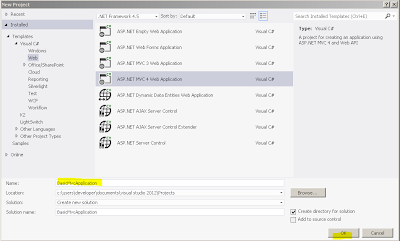
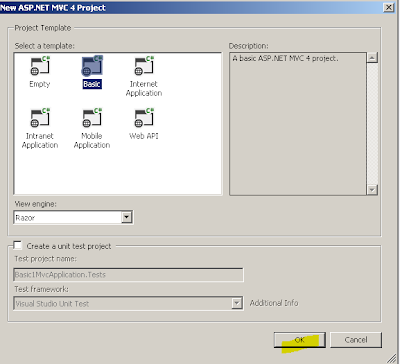
















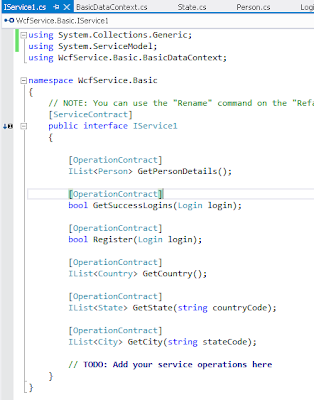










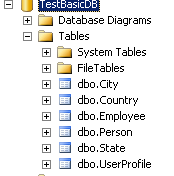



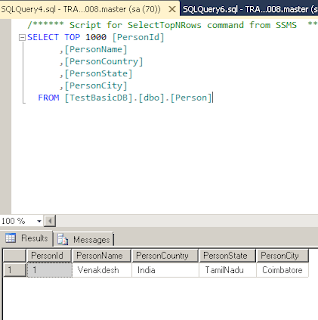

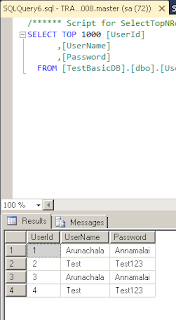










Comments
Post a Comment